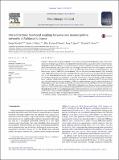| dc.contributor.author | Putcha, Deepti | en_US |
| dc.contributor.author | Ross, Robert S. | en_US |
| dc.contributor.author | Cronin-Golomb, Alice | en_US |
| dc.contributor.author | Janes, Amy C. | en_US |
| dc.contributor.author | Stern, Chantal E. | en_US |
| dc.date.accessioned | 2015-03-02T17:37:15Z | |
| dc.date.issued | 2015 | en_US |
| dc.identifier.citation | Putcha, Deepti, Robert S. Ross, Alice Cronin-Golomb, Amy C. Janes, and Chantal E. Stern. 2015. “Altered intrinsic functional coupling between core neurocognitive networks in Parkinson's disease.” NeuroImage : Clinical 7 (1): 449-455. doi:10.1016/j.nicl.2015.01.012. http://dx.doi.org/10.1016/j.nicl.2015.01.012. | en |
| dc.identifier.issn | 2213-1582 | en |
| dc.identifier.uri | http://nrs.harvard.edu/urn-3:HUL.InstRepos:14065309 | |
| dc.description.abstract | Parkinson's disease (PD) is largely attributed to disruptions in the nigrostriatal dopamine system. These neurodegenerative changes may also have a more global effect on intrinsic brain organization at the cortical level. Functional brain connectivity between neurocognitive systems related to cognitive processing is critical for effective neural communication, and is disrupted across neurological disorders. Three core neurocognitive networks have been established as playing a critical role in the pathophysiology of many neurological disorders: the default-mode network (DMN), the salience network (SN), and the central executive network (CEN). In healthy adults, DMN–CEN interactions are anti-correlated while SN–CEN interactions are strongly positively correlated even at rest, when individuals are not engaging in any task. These intrinsic between-network interactions at rest are necessary for efficient suppression of the DMN and activation of the CEN during a range of cognitive tasks. To identify whether these network interactions are disrupted in individuals with PD, we used resting state functional magnetic resonance imaging (rsfMRI) to compare between-network connectivity between 24 PD participants and 20 age-matched controls (MC). In comparison to the MC, individuals with PD showed significantly less SN–CEN coupling and greater DMN–CEN coupling during rest. Disease severity, an index of striatal dysfunction, was related to reduced functional coupling between the striatum and SN. These results demonstrate that individuals with PD have a dysfunctional pattern of interaction between core neurocognitive networks compared to what is found in healthy individuals, and that interaction between the SN and the striatum is even more profoundly disrupted in those with greater disease severity. | en |
| dc.language.iso | en_US | en |
| dc.publisher | Elsevier | en |
| dc.relation.isversionof | doi:10.1016/j.nicl.2015.01.012 | en |
| dc.relation.hasversion | http://www.ncbi.nlm.nih.gov/pmc/articles/PMC4320252/pdf/ | en |
| dash.license | LAA | en_US |
| dc.subject | Parkinson's disease | en |
| dc.subject | fMRI | en |
| dc.subject | Functional connectivity | en |
| dc.subject | DMN | en |
| dc.subject | SN | en |
| dc.subject | CEN | en |
| dc.title | Altered intrinsic functional coupling between core neurocognitive networks in Parkinson's disease | en |
| dc.type | Journal Article | en_US |
| dc.description.version | Version of Record | en |
| dc.relation.journal | NeuroImage : Clinical | en |
| dash.depositing.author | Ross, Robert S. | en_US |
| dc.date.available | 2015-03-02T17:37:15Z | |
| dc.identifier.doi | 10.1016/j.nicl.2015.01.012 | * |
| dash.contributor.affiliated | Ross, Robert | |
| dash.contributor.affiliated | Stern, Chantal | |
| dash.contributor.affiliated | Janes, Amy | |


